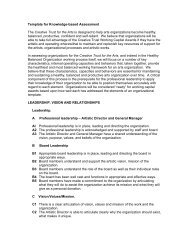20 Questions - Canadian Institute of Chartered Accountants
20 Questions - Canadian Institute of Chartered Accountants
20 Questions - Canadian Institute of Chartered Accountants
You also want an ePaper? Increase the reach of your titles
YUMPU automatically turns print PDFs into web optimized ePapers that Google loves.
in delivering the appropriate quality <strong>of</strong> service. Qualitative measures can be<br />
expressed in numbers by using such techniques as surveying people and recording<br />
the results. You can’t count a smile, but you can ask people to rate their<br />
satisfaction on a scale <strong>of</strong> 1 to 5.<br />
Expressing objectives as ratios and percentages can be a valuable technique for<br />
presenting and comparing results. To say that 90% <strong>of</strong> donations were used to<br />
provide services adds valuable information to the actual amount spent. Adding<br />
words and pictures to the numbers is also an effective way to convey information<br />
on achievements.<br />
There’s an old concept that a good thing carried to an extreme becomes a bad<br />
thing. This can be very true for performance measurements, particularly when<br />
an organization places undue emphasis on meeting targets and recognizing<br />
achievements. For example: if volume <strong>of</strong> results is overemphasized, quality may<br />
suffer, and vice-versa. Objectives must be clearly thought out and balanced to<br />
avoid unintended consequences.<br />
Within this overall framework, it is useful to keep in mind that “less is more”.<br />
A thorough focus on, and discussion <strong>of</strong>, two or three important measures can<br />
be far more effective than plowing through many pages <strong>of</strong> operational detail.<br />
Recommended practices<br />
• There are a manageable number <strong>of</strong> quantitative and qualitative measurements<br />
that indicate the organization’s strategic progress<br />
• The measurements are appropriate for monitoring the organization’s<br />
performance<br />
• The targets are realistic<br />
Outputs and outcomes<br />
Outputs are the services and products produced by the activities <strong>of</strong><br />
staff and volunteers. Outputs can range from answering a phone call<br />
or issuing a cheque to performing a surgical procedure or holding an<br />
event.<br />
Intermediate outcomes are the immediate benefits and changes<br />
resulting from the outputs. For example: satisfied users, jobs found,<br />
better decisions made.<br />
Ultimate (or end) outcomes are final or long-term consequences. For<br />
example: improved health, safe streets, reduced poverty.<br />
Example <strong>of</strong> a sequence <strong>of</strong> targets<br />
A program to save lives by reducing drinking and driving included a<br />
high-school program that recruited and trained students to organize<br />
events within their school with particular emphasis on graduation. The<br />
program measurements included:<br />
Outputs<br />
• The organization’s success as measured by the number <strong>of</strong> schools<br />
signed up and students trained.<br />
Intermediate outcomes<br />
• Each school’s success as measured by the number <strong>of</strong> events and<br />
participants.<br />
Ultimate outcome<br />
• The overall program results as measured by changes in the number<br />
<strong>of</strong> drinking-driving incidents.<br />
Examples <strong>of</strong> measurable targets<br />
Do we have the right measures?<br />
“You get what you measure.<br />
Measure the wrong thing and you get the wrong behaviors.”<br />
John T. Lingle<br />
• Increase membership by 10% this year<br />
• Win 25 medals in the next Winter Olympic Games<br />
• Stage five plays each year<br />
• Cut waiting times for specific medical procedures to provincial<br />
standards<br />
• Achieve a 90% satisfaction rating from the users <strong>of</strong> our services<br />
13












